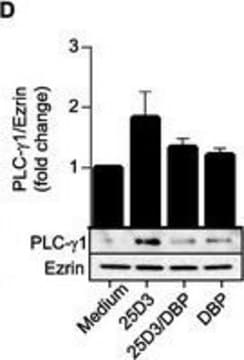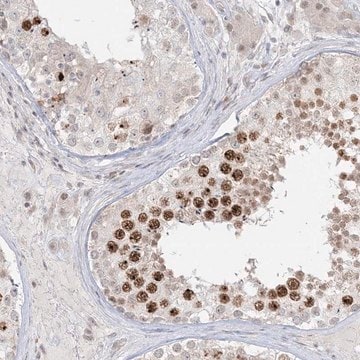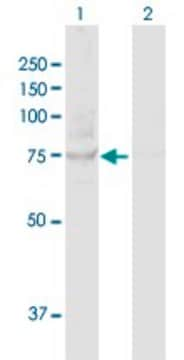일반 설명
We are committed to bringing you greener alternative products, which adhere to one or more of The 12 Principles of Green Chemistry.This antibody is Preservative-free, produced without the harm or sacrifice of animals and exceptionally stable to allow for ambient shipping and storage if needed and thus aligns with "Waste Prevention", "Designing Safer Chemicals" and "Design for Energy Efficiency".
Click here for more information.
ZooMAb® antibodies represent an entirely new generation of recombinant monoclonal antibodies.
Each ZooMAb® antibody is manufactured using our proprietary recombinant expression system, purified to homogeneity, and precisely dispensed to produce robust and highly reproducible lot-to-lot consistency. Only top-performing clones are released for use by researchers. Each antibody is validated for high specificity and affinity across multiple applications, including its most commonly used application. ZooMAb® antibodies are reliably available and ready to ship when you need them.
특이성
Clone 1H21 is a ZooMAb® Rabbit recombinant monoclonal antibody that specifically detects PLCg1. It targets an epitope within 20 amino acids from the C-terminal region.
면역원
KLH-conjugated linear peptide corresponding to 20 amino acids from the C-terminal of human PLCg1.
애플리케이션
Quality Control Testing
Evaluated by Western Blotting in HEK293T cell lysate.
Western Blotting Analysis: A 1:1,000 dilution of this antibody detected PLC 1 in HEK293T cell lysate.
Tested applications
Western Blotting Analysis: A 1:1,000 dilution from a representative lot detected PLC 1 in Neuro2A, NIH3T3, and C6 cell lysates.
Immunohistochemistry (Paraffin) Analysis: A 1:100 dilution from a representative lot detected PLC 1 in human kidney tissue sections.
Affinity Binding Assay: A representative lot of this antibody bound PLC 1 with a KD of 1.7 x 10-6 in an affinity binding assay.
Note: Actual optimal working dilutions must be determined by end user as specimens, and experimental conditions may vary with the end user
표적 설명
1-phosphatidylinositol 4,5-bisphosphate phosphodiesterase gamma-1 (UniProt: P19174; also known as EC:3.1.4.1, PLC-148, Phosphoinositide phospholipase C-gamma-1, Phospholipase C-II, PLC-II, Phospholipase C-gamma-1, PLC-gamma-1) is encoded by the PLGC1 (also known as PLC1) gene (Gene ID: 5335) in human. PLCg1 mediates the production of second messenger molecules diacylglycerol (DAG) and inositol 1,4,5-triphosphate (IP3) and plays a vital role in the regulation of intracellular signaling cascades. It is phosphorylated and activated in response to ligand-mediated activation of multiple receptor tyrosine kinases, including EGFR, FGFR, and PDGF. PLCg1 contains a long linker sequence between the X (aa 320-464) and Y (aa 953-1070) regions. This linker consists of split halves of a PH domain (aa 489-523 and 895-931) flanking two SH2 domains (aa 550-657 and 668-756) and a SH3 domain (aa 791-851). SH2 domain is phosphotyrosine-containing peptide sequences, while SH3 domain interacts with proline-rich sequences. Although separated by a large insertion, halves of the split PH domain assume a canonical PH fold. The linker region also contains a highly conserved Tyr residue (Tyr783) and its phosphorylation is essential for the activation process. The linker region plays a central role in the regulation of PLCg. Upon activation, growth factor receptors with intrinsic PTK activity undergo autophosphorylation to provide docking sites for many proteins required for the downstream signaling. PLC- binds these phosphotyrosine-containing docking sites via its N-terminal SH2 domain, and its conserved Tyr residue is phosphorylated by the PTK. Phosphorylated PLCg then expresses its otherwise autoinhibited phospholipase activity via the intramolecular interaction between the phosphorylated Tyr residue and the C-terminal SH2 domain. This ZooMAb recombinant monoclonal antibody, generated by our propriety technology, offers significantly enhanced specificity, affinity, reproducibility, and stability over conventional monoclonals. (Ref.: Hajicek, N., et al. (2019). eLife 2019;8:e51700; Law, CL., et al. (1996). Mol. Cell Biol. 16(4); 1305-1315).
물리적 형태
Purified recombinant rabbit monoclonal antibody IgG, lyophilized in PBS, 5% Trehalose, normal appearance a coarse or translucent resin. The PBS/trehalose components in the ZooMAb formulation can have the appearance of a semi-solid (bead like gel) after lyophilization. This is a normal phenomenon. Please follow the recommended reconstitution procedure in the data sheet to dissolve the semi-solid, bead-like, gel-appearing material. The resulting antibody solution is completely stable and functional as proven by full functional testing. Contains no biocide or preservatives, such as azide, or any animal by-products. Larger pack sizes provided as multiples of 25 μL.
재구성
300 μg/mL after reconstitution at 25 μL per vial. Please refer to guidance on suggested starting dilutions and/or titers per application and sample type.
저장 및 안정성
Recommend storage of lyophilized product at 2-8°C; Before reconstitution, micro-centrifuge vials briefly to spin down material to bottom of the vial; Reconstitute each vial by adding 25 μL of filtered lab grade water or PBS; Reconstituted antibodies can be stored at 2-8°C, or -20°C for long term storage. Avoid repeated freeze-thaws.
법적 정보
ZooMAb is a registered trademark of Merck KGaA, Darmstadt, Germany
면책조항
Unless otherwise stated in our catalog or other company documentation accompanying the product(s), our products are intended for research use only and are not to be used for any other purpose, which includes but is not limited to, unauthorized commercial uses, in vitro diagnostic uses, ex vivo or in vivo therapeutic uses or any type of consumption or application to humans or animals.









